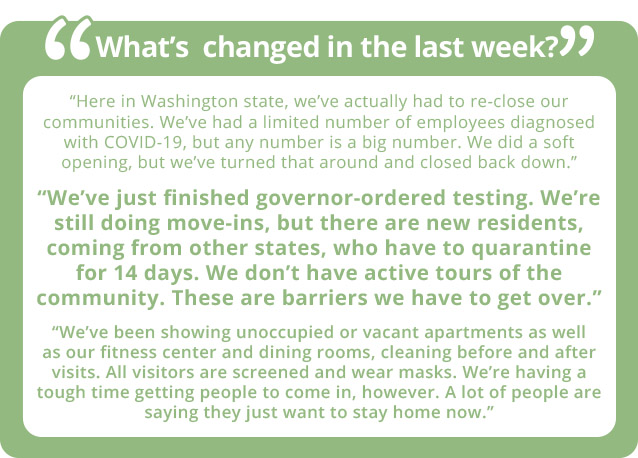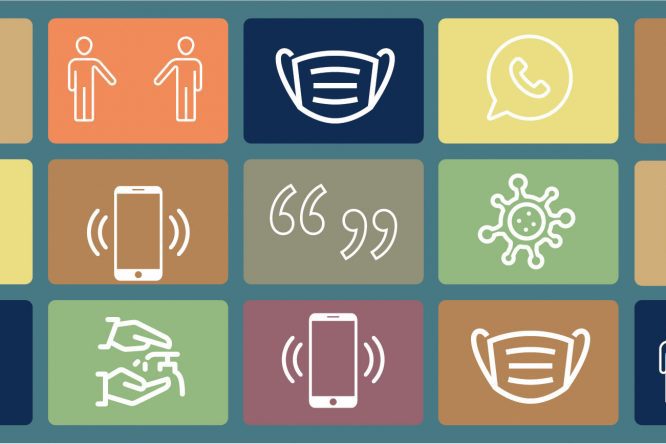At Thursday’s sales and marketing roundtable, communities met virtually to discuss their reopening challenges. Mark Ingram, CEO of SenioROI, joined us to share his thoughts on direct marketing and list procurement in the time of COVID-19.
Check out the recap of our discussion below. Please also join us for our next sales and marketing roundtable, coming up next week.

Today’s guest: Mark Ingram, CEO, SenioROI
SeniorROI has worked in the retirement industry for 20 years and offers a variety of services related to data on senior living. We lived through the 2008 financial crisis, but this is different. This situation will last longer, and it’s already having a different effect on the industry. Some of the creative methods we’re using may stay around after the crisis, but we have to get through this. Here are some tips to connect with prospects:
- Stay productive now, and prepare for what’s next
- Lessons learned from 2008
- Stay in front of waiting lists
- Follow up on leads
- Mail (mass and personal)
- Phone calls
- Curated gift boxes targeted to your prospects (senior-related, COVID-19-related, people whose adult children live far away)—the gifts let people know you’re thinking about them and brighten their day
- Send a meal from the community to the top 5% of the database
- Use time wisely to capture the leads that are ready!
- Lessons learned from 2008
- What can you do right now?
- Harness the power of your CRM. Clean up your internal database. Determine how many of your leads have moved to a competitor, how many are deceased and how many have moved out of the target market. (In case of a death, append the spouse’s name—it could trigger a buying behavior.)
- Append demographics. You can do a reverse-append from email, and/or mobile, to get the postal data 50 or 60% of the time. If you have the postal data, you can append home equity, age, financial information, spouse’s name and age, or third person in home. Put the info in your CRM using custom fields—and make sure the sales team knows how to use it. Example: “We’ve got a one-bedroom unit; let’s find all the single females who can afford it.” Think about different scenarios, and get the sales team comfortable with appended data. Once you understand the prospect, it changes the conversation and helps the sales team dramatically.
- Create a profile of your best prospects. Look at age, financial and geographic information that will help you buy the right list. Once you have the list, you can do direct mail, but it’s not the only thing you can do with a database. When you have the postal addresses, you can match individuals on Facebook. Some of the highest match rates will be through mobile devices and email, but you need a postal address to do that. Once you can match people on Facebook, you can serve them digital ads, through addressable geo-fencing, that go to their phone, laptop and desktop. Note: Addressable geofencing is essentially putting a digital fence around their address and serving ads to devices that are active in that zone. Looking at the database a little differently is extremely important to maximizing its value, or what you get out of it.
- How many records do you need to create a profile? You need about 300 to 500 records. There are different segments in the profile. One is existing residents, which can go back 2 to 3 years, but the most relevant data is within the last year. Every status code should create a profile—a move-in, a tour, a lost lead.
- Tips on purchasing a list: When you’re buying data, ask specific questions. Three to 10 percent of the data is outdated the day that you get it—that’s the acceptable percentage in the industry. People have moved out of the market, are deceased, etc. Ask your list provider: How often is the data updated? What compiler is it coming from? There are a ton of sources, some better than others; all have strengths and weaknesses. Some of the best data comes from using a multi-source compiler—that’s what we do. Ask specific questions.
- Direct mail during COVID-19—does it work?
- It can definitely work and be part of your overall marketing plan:
- Success story: After a $21,000 spend, a client got the following results: “After cleaning up our database, and appending key demographic and financial data, including email addresses, we identified metrics for a new purchased list for lead generation. This led to a successful webinar series, generating 164 new leads, 5 new sales and 5+ wait-list sales in just two weeks.” – Jeanne La Roe, Marketing Director, Givens Estates
- It can definitely work and be part of your overall marketing plan:
- Is there a concern with touching mail that comes to the house?
- We’ve got some research from the Postal Service, and one of the direct marketing associations, that shows there is no evidence of COVID-19 being spread through the mail. Prospects look forward to going to the mailbox—it may be the only thing they’re doing to get out of the house every day
- Here’s some information on this question:
- From CBS News
- From the USPS
- From the CDC: “There is still a lot that is unknown about COVID-19 and how it spreads. Coronaviruses are thought to be spread most often by respiratory droplets. Although the virus can survive for a short period on some surfaces, it’s unlikely to be spread from domestic or international mail, products or packaging. However, it may be possible that people can get COVID-19 by touching a surface, or object that has the virus on it, and then touching their own mouth, nose, or possibly their eyes, but this is not thought to be the main way the virus spreads.”
- What can you do if people get mail for a deceased loved one and threaten to sue? Each community should keep its own “do not mail” list on file. As these calls come in, address the issues, and provide callers with a link to be removed from lists. Make sure you have that “do not mail/call” list, and make sure your provider is taking people off the list. Deceased suppression should be run every time you send a direct mail. Doing that decreases the chance that you will get a call like that. Most people who aren’t in the retirement industry don’t understand why this is so important.
Please join our next roundtable discussion on Thursday, August 6, at noon ET.
For log-in information, contact DDunham@VarsityBranding.com.



